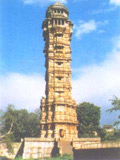|
Ajmer
Alwar
Bharatpur
Bikaner
Bundi
Chittorgarh
Jaipur
Jodhpur
Jaisalmer
Kota
Mount Abu
Ranthambore
Udaipur
(Return to GatewayforIndia - Tourism)

Chittorgarh
The
city of Chittorgarh and the Fort are situated at the distance of 112
kilometers away from Udaipur. It is built on a 550 feet high hill and
occupies an area of about 750 acres in about 8 miles of circumference.
This fort was built by Chitranganda Moraya in 7th century AD, and is
called ‘Chitrakut’. The name Chitrakut can be seen on the old coins of
Mewar state. According to Colonel James Todd, Bappa Rawal captured this
fort from the last Maurya ruler in the year 728 AD, and established the
Guhil rule. The pride and glory of
Rajasthan, Chittor echoes with the tales of romance and valor unique to
the Rajput Tradition. Cittor was attacked number of times by Muslim
invaders. The first
attack was by Alauddin Khilji in 1303 AD, who was enamored by the beauty
of Queen Padmini. Rani Padmini preferred death to abduction and dishonor
and committed jauhar along with the other ladies. The second
attack was in 1535 by Sultan Bahadur Shah of Gujarat on Bikramjeet. The
third instance was in 1567 when Akbar attacked during the time of Maharana
Udai Singh. This final attack was complete when the army looted and
destroyed all the buildings. The Mewars were forced to shift their
capital to Udaipur. Chittor stands for the heroism, chivalry, valor and
sacrifice, all inbuilt characteristics of Rajputs.
Places
of tourist
interest
The
Chittor Fort - There are seven gates in this historical fort - the
Padan pole, Bhairon pole, Hanuman pole, Ganesh pole, Jodha pole, Laxman
pole and Ram pol gates. The seventh gate Ram in the west is the
main entrance gate to the fort. There is a temple of Ram on right hand
side of this gate. There are several places in the fort to that remind us
of the bravery of Rajputs but some of them deserve special attention.
-
Navalakha Bhandar - There is a wall (burj) and a room in the
western part of the fort. It is said that the royal treasure was kept
here in old time. There was also a safe place to keep the weapons and
gunpowder.
-
Shringar chanwari - There is a Chhatri of six pillars and it is
said that it was built for the marriage of the daughter of Maharana
Kumbha. But according to the letters on the stone these should be the
Jain temples one can see the statue of Parswanath the Jain Tirthankar
and the dancing gods and goddesses in the outer side of this chhatri.
-
Maharana Kumbha’s palaces -The
ruined edifice of great historical and architectural interest, being the
most massive monument in the fort of Chittor. Maharana
Kumbha reconstructed these palaces. Through almost in ruins the palaces
include Suraj Mahal, Janana Mahal, Kanwarpada Mahal. There is also a
Shiva temple here. These palaces were witness to the legendry sacrifice
of Panna – the royal nurse and birth of Prince Udai Singh’s (founder of
Udaipur city) and Jauhar of Queen Padmini.
Fateh Prakash - Maharana Fateh Singh of Udaipur built it. A statue of
Lord Ganesh and a statue of Maharana Fateh Singh are present in this
palace.
Shrinagar Chauri :
Jain temple was built in 1448 A.D. in the ruling period of Rana Kumbha
Vijay Stambha - The victory tower was built by Maharana Kumbha in
the year 1448 to commemorate his victory over the joint attacks of Sultan
Mahmood Shah of Malwa and Sultan Kutubuddin Shah of Gujarat. The famous
Vijay pillar stands on a 12 feet high and 48 feet square elevated platform
and has a height of 123 feet. Vijay Stambha itself has nine stores and the
visitors can reach to the upper story through 157 steps. Width of this
Stambha at the base is 31 feet. The interiors and exteriors of the entire
structure are delicately carved showing Hindu deities and mythical
characters with names.
Meera temple - There is a small temple stands in the premises of
Kumbha Shyam temple believed to be associated with famous devotee Meera
Bai.
Samisheshwar temple - This Shiva temple was built by Raja Bhoj of
Malwa and later rebuilt by Maharaja Mokal in the year 1426 AD. There is
three-faced statue of Lord Shiva in this temple.
Kalika Mandir - It was originally a temple dedicated to Sun god but
later became a temple to worship Goddess Kali. The Guhil rulers built it
in 8th or 9th century. A large fair takes place at the time of Navratri.
Palace of Padmini - There is a palace at the bank of a lake and
another palace can be seen in the middle of the lake. It is said that
Allauddin Khilji had viewed the image of Queen Padmini from this very
place.
Kirthi stambha
-
These 70 feet high and seven-storied tower was built by Jain Mahajan Jeeja
in 12th century. It is dedicated to Jain Tirthankar Lord
Adinath whose 5 feet statue are incurved in ass the four faces of the
structure and many other statues in carving also can be seen at the
interior and outer part of the tower. A Jain temple of Mahaveer Swami is
also standing nearby. It was rebuilt during the period of Mahararana
Kumbha.
Menal : 95 Kms.
on the Bundi-Chittor raod amid the natural beauty is Menal, famous for its
ancient Shiva Temple, picturesque, water falls and dense forest.
Nav Torana Temple :
35 Km from the Chittorgarh, 11th century temple at Khor famous for its
unique & huge statue of Lord Vishnu in the form of a wild boar called "VARAH". |